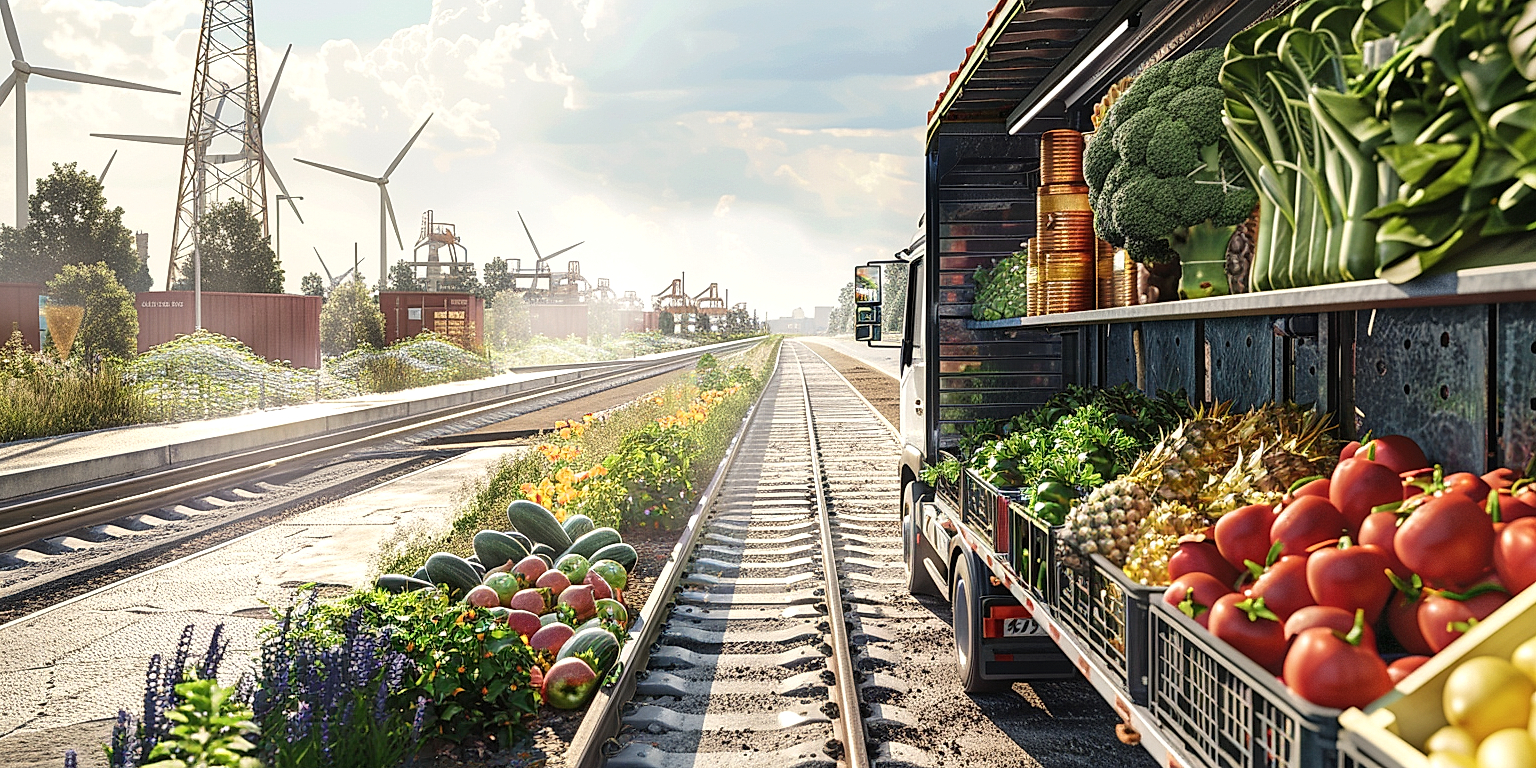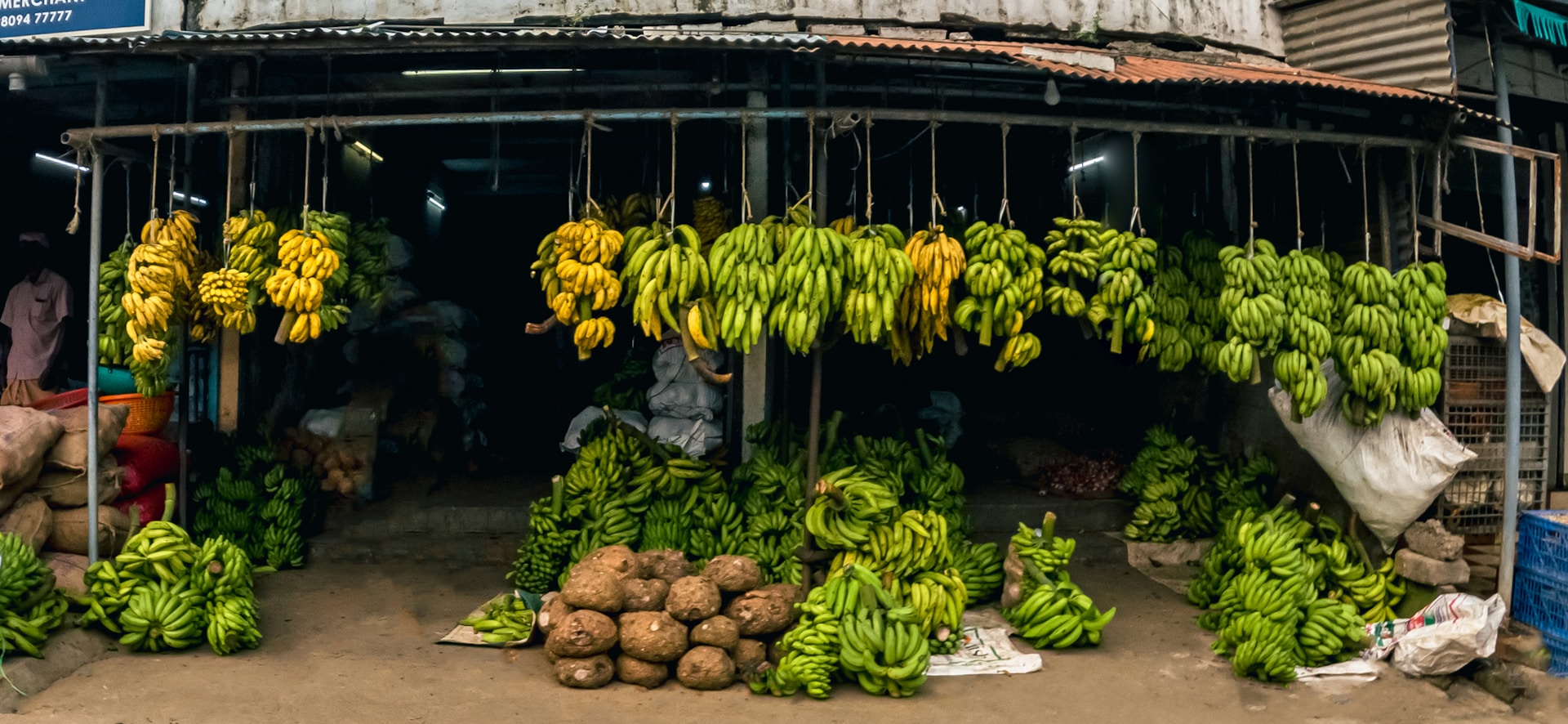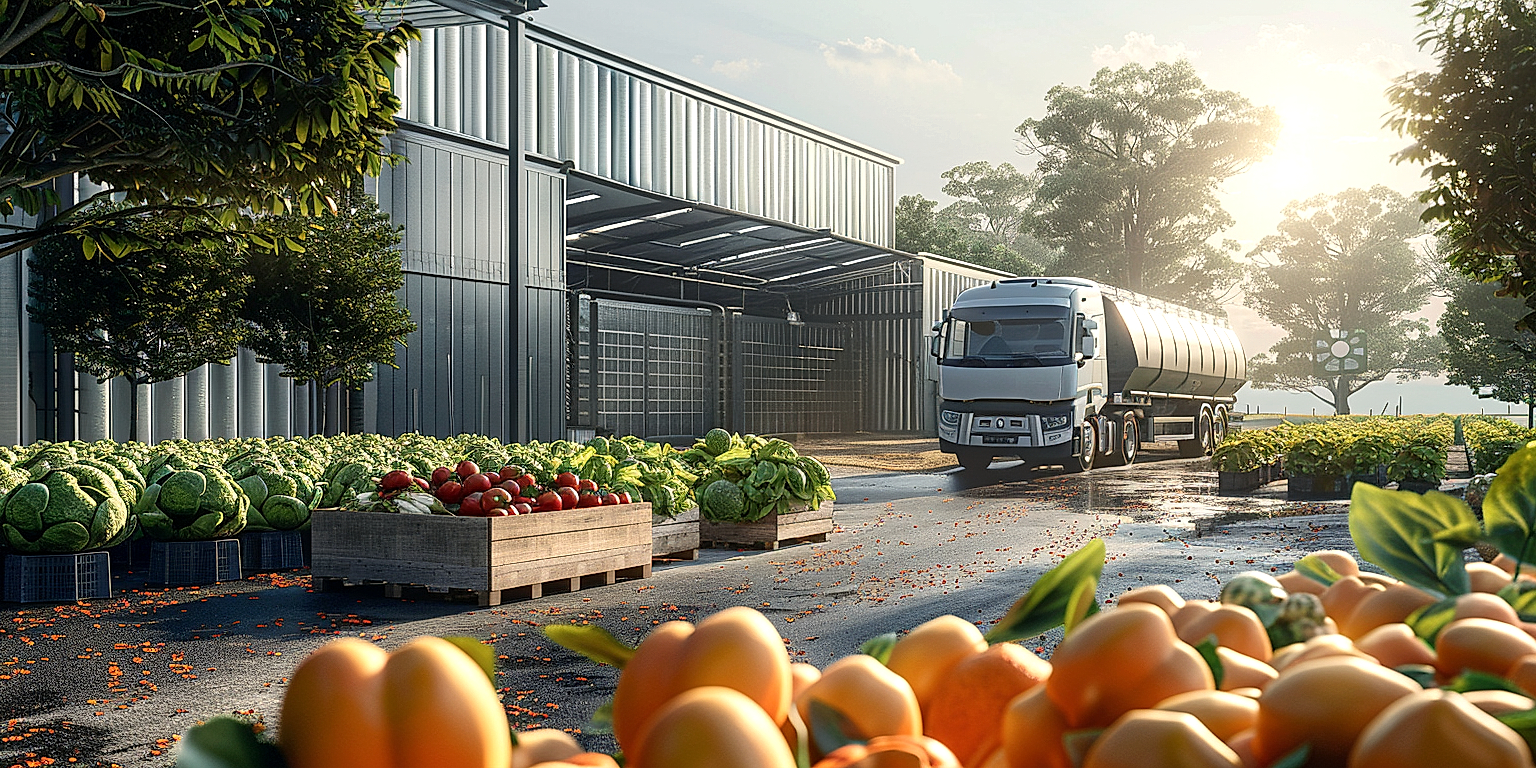Reducing carbon emissions in global supply chains is crucial to mitigating the impacts of climate change.
Actively seeking new methods to decrease these emissions, particularly in produce shipping, is an obligation we all share.
Analyzing and addressing this problem requires a multi-dimensional approach.
Technology, logistics improvements, behavioural changes, and policy measures all play important roles.
In this context, achieving lower carbon emissions is an end-goal that needs our collective effort and innovation.
This discussion presents practical solutions relevant to those directly involved, from growers to logisticians, as well as any invested stakeholder.
Contents
- Ways To Reduce Carbon Footprint In Produce Shipping
- 1. Use Electric or Hybrid Vehicles for Transportation
- 2. Optimize Shipping Routes for Fuel Efficiency
- 3. Use Eco-Friendly Packaging Materials
- 4. Centralize Distribution Centers to Minimize Travel
- 5. Encourage Bulk Purchasing to Reduce Trips
- 6. Develop Local Supply Chains
- 7. Use Renewable Energy Sources in Facilities
- 8. Prioritize Sea and Rail Over Air Transportation
- 9. Implement a No-Idle Policy for Trucks
- 10. Participate in Carbon Offset Programs
- The Bottom Line
Ways To Reduce Carbon Footprint In Produce Shipping
1. Use Electric or Hybrid Vehicles for Transportation
The rise of electric and hybrid vehicles is a significant development in efforts to reduce carbon footprint in various sectors, including produce shipping.
Traditionally, diesel-powered trucks dominate the shipping industry, emitting large amounts of carbon dioxide (CO2).
The use of electric or hybrid vehicles for transportation promises to alleviate this problem significantly.
Electric and hybrid vehicles are low-emission alternatives to conventional diesel trucks, perfectly aligning with the goal to reduce carbon footprint in produce shipping.
Electric vehicles run on batteries and do not emit any CO2 during operation.
On the other hand, hybrid vehicles use a combination of an internal combustion engine and one or more electric motors, drastically cutting down CO2 emissions by supplementing the engine’s power with electricity.
The switch to these eco-friendly vehicles, however, may not be as simple as it seems as it includes a full range of considerations.
For instance, how readily available are these alternative vehicles in the market?
Are they available at a competitive price and are they financially viable for a shipping company to invest in?
If a company decides to replace its entire fleet, they may face the need for significant initial capital outlay.
Another important factor that comes into play here is the range limitation of electric vehicles.
While electric vehicle technology is advancing at a rapid pace, it is still generally accepted that electric vehicles have a lower range compared to diesel-powered trucks.
Therefore, the routes and volumes that the vehicles are meant for would need to be carefully considered to ensure that they do not run out of power midway.
These are just a handful of the issues that need to be resolved to increase the uptake of electric and hybrid vehicles in the shipping industry.
Nevertheless, the benefits that come with their use such as reduced CO2 emissions, lower maintenance costs, and a quieter and smoother ride, make them a worthwhile investment in the long run.
Therefore, it is vital that produce shipping companies take responsibility and start seriously considering these alternative vehicles for the future of sustainable transportation.
Innovation encourages efficiency, and sustainability demands it – embracing electric and hybrid vehicles can be the game-changer in reducing carbon footprint in produce shipping.
2. Optimize Shipping Routes for Fuel Efficiency
One of the most significant ways to reduce carbon emissions in produce shipping is by optimized shipping routes for fuel efficiency.
This means, making use of advanced technology and software to plot the most direct and efficient routes for delivery trucks, ships and other freight transportation modes.
This optimization process must consider multiple factors that can affect fuel efficiency, such as traffic, road conditions, weather, and the weight of the cargo.
Implementing more direct transportation routes can significantly reduce the amount of fuel used, thus lowering the carbon emissions associated with produce shipping.
Moreover, the planning of routes should include actuality scalability considerations to cater to fluctuations in demand.
In other words, the frequency and quantity of the produce deliveries should be adjusted based on real-time demand dynamics.
This will not only reduce fuel consumption, but also minimize wasted mileage driven for low-demand routes, further decrementing the carbon footprint.
The commitment to this optimization will necessitate investing in fleet management software that can accommodate dynamic scheduling and adapt to changes in real-time.
This technology is a valuable asset because it empowers businesses to make the most efficient use of their resources, therefore maximizing profitability while also decreasing their environmental impact.
Furthermore, adopting the practice of manual route optimization by experienced dispatchers can also significantly improve fuel efficiency.
They can quickly identify bottleneck situations and make adjustments that automated systems might miss.
However, it’s important to keep a balance between automated systems and manual intervention so as to not to over-rely on either method and keep the system adaptive and resilient.
Considering the magnitude of carbon emissions derived from shipping, it becomes apparent that optimized shipping routes can have a large impact on a company’s overall carbon footprint.
Hence, making an effort to optimize shipping routes can majorly contribute to the goal of reducing carbon footprint in produce shipping.
It’s an effort that requires consideration, commitment and the willingness to change old habits, but the environmental benefits it yields make it completely worth it.
In the grand scheme of things, taking such an approach will mark an essential step towards more sustainable and responsible shipping practices, paving the way for a greener future.
3. Use Eco-Friendly Packaging Materials
One key factor in minimizing the carbon footprint of produce shipping is embracing the usage of eco-friendly packaging materials.
In the shipping industry, traditional packaging materials like plastic and polystyrene have been widely utilized. However, these materials are not biodegradable and contribute significantly to pollution and carbon emissions.
Notably, eco-friendly packaging solutions, such as biodegradable plastics, do exist and offer a much greener alternative.
These packaging alternatives break down naturally over time into non-toxic components, unlike traditional packaging materials which can take centuries to decompose, releasing harmful chemicals in the process.
Moreover, eco-friendly packaging materials are often made from recycled materials. This reduces the need for fresh resources and thereby, further mitigating the overall carbon footprint.
Unveiling these positive characteristics, it’s clear that choosing eco-friendly materials for packaging is a major step towards establishing a greener and more responsible produce shipping industry.
Styrofoam, for instance, a common packaging material, can be replaced with mushroom-based packaging. Mushroom packaging is not only biodegradable but also made from agricultural waste, making it doubly eco-friendly.
Eco-friendly packaging also extends to shipping boxes and packaging tapes. Companies can opt for shipping boxes made from recycled cardboard and tapes made from paper and natural rubber.
Additionally, suppliers can reduce their carbon footprint by using packing peanuts made from starch instead of polystyrene.
Using packaging solutions like biodegradable air pillows, which are made from cornstarch, also substantially offset the carbon emissions.
A transition to these alternatives not only promotes a healthier planet but also sends a potent message to consumers about the company’s commitment to sustainability.
However, one should note that adopting eco-friendly packaging materials may involve a cost increase for businesses. Nonetheless, these higher costs can often be offset by the benefits of reduced carbon emissions and better brand image.
Ahead of the curve, several companies have already started their journey towards using more eco-friendly packaging materials, recognizing the urgency of addressing climate change.
Emphasizing the need for such a switch in materials, this underlines the import of eco-friendly packaging solutions as an effective means to cut down carbon emissions in the world of produce shipping.
4. Centralize Distribution Centers to Minimize Travel
The approach of centralizing distribution centers is a practical concept aiming to minimize the need for long-distance transport and consequently reducing the carbon footprint caused by produce shipping.
This method operates on the principle of consolidating multiple distribution points into a single, centralized location, minimizing the distance between the production site and the major markets.
By having a central hub, it’s also easier to implement energy-efficiency measures, such as using renewable energy sources and optimizing travel routes.
Centralizing distribution centers can significantly diminish the number of miles driven, as products will be traveling shorter distances, which ultimately lowers the volume of greenhouse gases released into the atmosphere.
With multiple, scattered distribution centers, the same consignment often has to be transported over longer distances, and the same areas can be unnecessarily serviced multiple times, incurring both additional fuel consumption and carbon emissions.
The act of relocalizing distribution can also result in reduced congestion on highways and other transit routes, which in and of itself can lead to a decrease in emissions.
Logistics and supply chain managers should be looking to partner up with other businesses to share distribution centers, decreasing the overall demand for transportation and leading to substantial energy savings.
Localized storage methods, such as cool or cold storage warehouses, can be strategically placed in these central locations, reducing energy consumption and thus making a positive impact on the environment.
Furthermore, implementing the idea of a circular economy can also help in the centralization process. This can be achieved by making use of by-products and returning them back to the central hub, cutting down additional transport requirements.
It is also imperative that a keen eye is kept on potential negative impacts that may arise from centralizing distribution centers; these could potentially include heightened traffic congestion in urban areas where they are often located, the effect on local retail businesses who may have to travel further for stock, and concerns regarding noises and increased pollution levels in the immediate area. As such, it’s of utmost importance that careful planning and consideration is applied before execution.
In summary, centralizing distribution centers can lead to a decrease in travel distance, saving energy and reducing carbon emissions. It’s a strategic move that needs careful implementation, but is undoubtedly a powerful tool in the drive towards carbon neutrality in the produce shipping sector.
5. Encourage Bulk Purchasing to Reduce Trips
In the context of reducing carbon footprint in produce shipping, an effective method is to encourage bulk purchasing.
By consolidating smaller orders into a larger shipment, we can reduce the number of trips needed to transport goods.
This practice not only minimizes the overall carbon emissions associated with freight transportation but also optimizes the use of energy.
Furthermore, the efficiency gained from reduced fuel consumption contributes towards substantial cost savings in the long run.
Let’s not underestimate the importance of bulk buying in reducing not only carbon emissions but overall environmental impact associated with transport of goods.
In terms of logistics management, encouraging bulk purchases means fewer deliveries, thus fewer vehicles are needed on the road.
The reduction in vehicular traffic subsequently leads to a lower greenhouse gas (GHG) emissions.
Encouraging bulk purchases doesn’t just result in a smaller carbon footprint, it also reduces traffic congestion, leading to a more streamlined logistics process.
In the light of climate change, businesses and consumers alike should be encouraged to transition towards more sustainable and eco-friendly practices, such as bulk buying.
Raising awareness about the environmental impact of our purchasing decisions is crucial in fostering more conscious consumer behavior.
Government and regulatory bodies can also play a significant role in promoting bulk purchases through establishing favorable policies and incentives.
Remember, small changes in our purchasing habits can lead to remarkable transformations in our carbon footprint.
After all, the goal is not just about cutting costs but more importantly, about preserving the environment for future generations.
In conclusion, bulk purchasing is a simple yet significant step in our collective efforts towards a green and sustainable future.
6. Develop Local Supply Chains
A significant way to reduce the carbon footprint in produce shipping is by developing local supply chains.
Local supply chains often involve shorter shipping distances, which can highly reduce the amount of fuel consumed and, consequently, the amount of carbon emissions.
In addition to the environmental benefits, local supply chains also have economic and social advantages.
They often promote local economies, create jobs and foster the development of local industries and businesses.
Buying from local suppliers can also help to ensure freshness and quality of the produce, as they don’t have to travel long distances and are often harvested at peak ripeness.
More, local suppliers are often more responsive and flexible to the needs of their customers, providing better customer service and a more personalized approach to business.
However, developing local supply chains is not without its challenges.
Local suppliers may not always be able to meet the demand for certain products, especially out of season.
Besides, local produce may be somewhat more expensive than produce shipped from other parts of the world, where labor and land costs may be lower.
But despite these challenges, developing local supply chains can still be a viable and sustainable option for many businesses.
It can begin with an assessment of local suppliers, their products and capabilities.
The next step can be building relationships with these suppliers, establishing purchasing agreements and logistics arrangements.
A key aspect in developing local supply chains is committed and active involvement from the management of the company.
In the long run, creating local supply chains will not only reduce carbon footprints in shipping but also contribute significantly to building a more sustainable and resilient economy and community.
On balance, developing local supply chains seems a promising and effective way to reduce carbon footprint in produce shipping.
7. Use Renewable Energy Sources in Facilities
One of the most significant ways to reduce carbon footprint in produce shipping is by powering facilities with renewable energy sources.
Many traditional methods of electricity generation, such as those that use coal or natural gas, produce greenhouse gases that directly contribute to climate change.
Switching to renewable energy, though, almost completely cuts out these emissions.
There are several types of sources for renewable energy, including solar, wind, hydro, and geothermal power.
Of these, solar power is an excellent choice for most organizations, as it is very versatile and relatively easy to install.
Solar panels can be placed on rooftops or other areas that receive plenty of sunlight, and after the initial installation cost, the energy they generate is essentially free.
Importantly, switching to renewable energy can often be a significant cost-saving measure in the long term.
While the initial investment can be high, the savings in energy costs over time are often substantial enough to offset this.
Indeed, many renewable energy systems actually produce more power than they consume, allowing businesses to sell excess energy back to the grid.
Furthermore, using renewable energy can improve a company’s public image, as it demonstrates a clear commitment to sustainability and social responsibility.
This can lead to improved community relations and potentially attract new customers who place a high value on environmental stewardship.
Another advantage of using renewable energy sources is that, unlike fossil fuels, they will not run out.
This fact provides a level of reliability and predictability that can be very valuable in planning and budgeting.
Finally, many governments offer significant incentives and rebates for companies that install renewable energy sources, making the switch an even more attractive proposition.
Overall, the use of renewable energy sources in produce shipping facilities represents a significant opportunity to reduce carbon footprint, save money, and improve a company’s image.
Therefore, any business wanting to make real strides in sustainability should strongly consider integrating renewable energy into their operations.
8. Prioritize Sea and Rail Over Air Transportation
When discussing ways to reduce the carbon footprint of produce shipping, a significant strategy to consider is prioritizing sea and rail over air transportation.
In relation to greenhouse gas emissions, air transport is indisputably the most harmful to the environment.
Rail and maritime transportation, on the other hand, are much more fuel-efficient means of freight transport.
By selecting sea and rail options over air transport, companies can drastically slash their carbon emissions and contribute to global carbon reduction efforts.
It’s worth noting not just the carbon emissions from the transportation itself but also the emissions produced during the construction and maintenance of transport infrastructure.
Aircraft, for instance, require airports with large runways, which cause significant environmental disruption.
Contrastingly, railways and seaports, though not impact-free, tend to have less drastic ecological footprints.
Another aspect to consider is that large volumes of goods can be moved by cargo ship or freight train, making them highly efficient means of transportation for produce.
Whilst air transport can be quicker, the heavy carbon cost renders it a less sustainable choice.
Many companies have started to recognize this reality and are actively choosing to ship their goods via sea or rail.
It’s crucial to understand that shifting modes of transport won’t have an immediate impact on carbon emissions; however, this is a long-term strategy aimed at progressively reducing carbon footprints.
Implementing these changes will involve a combination of logistical planning, infrastructure development, and a shift in company policy and mentality.
However, the payoff is a substantial reduction in greenhouse gas emissions, which helps companies meet their environmental goals and contributes to global efforts to combat climate change.
While shifting from air to rail and sea transportation may present initial challenges, the long-term environmental benefits make this a worthwhile endeavor.
By rethinking our transportation choices in produce shipping, we can make strides in our quest to reduce our industry’s—and our planet’s—carbon footprint.
9. Implement a No-Idle Policy for Trucks
One of the most impactful ways that produce shipping companies can reduce their carbon footprint is to implement a no-idle policy for trucks.
No-idle policies can have a significant impact on reducing emissions, as the largest portion of a truck’s carbon footprint often comes from unnecessary idling.
Excessive idling occurs when truckers keep their engines running during breaks, loading and unloading times, and waits at traffic signals or other delays.
This unnecessary idling significantly increases fuel consumption, adding to the overall carbon emissions of the shipping process.
According to studies, an hour of idling can burn up to a gallon of fuel, which, if calculated over time, can result in a significant increase in a company’s carbon footprint.
Implementing a no-idle policy can significantly reduce these emissions, promoting a more eco-friendly and sustainable produce shipping process.
To make a no-idle policy effective, companies need to invest in driver training and awareness.
When drivers understand the carbon implications of unnecessary idling, they are likely to make better decisions that result in less fuel being burnt unnecessarily.
Additionally, deploying advanced technology can also help enforce no-idle policies.
For instance, employing automatic engine shut-off systems or telematics systems can help control unnecessary idling of trucks.
Another effective way to lower unnecessary idling is to explore innovative idle-reduction technologies available in the market.
These technologies like auxiliary power units, direct fired heaters, and thermal storage systems operate the necessary features of the truck while turning off the main engine, thus reducing fuel consumption.
The up-front investment costs of these technologies may deter some companies, but it’s essential to weigh these against the long-term environmental and cost benefits.
All these methods combined make the implementation of a no-idle policy a tangible and effective strategy for reducing the carbon footprint in produce shipping.
While it does require some initial investment and modifications to current operations, the long-term benefits to the environment and the company’s sustainability commitments make it a worthy endeavor.
10. Participate in Carbon Offset Programs
Companies engaged in produce shipping have a significant role to play in reducing the planet’s carbon footprint.
To achieve this, a feasible strategy is to participate in carbon offset programs.
These programs are designed to neutralize the amount of carbon dioxide a company releases into the atmosphere by investing in projects that lead to equal carbon savings elsewhere.
Carbon offset programs work by funding renewable energy projects, forest restoration efforts or energy efficiency initiatives that capture or reduce greenhouse gases.
The benefits of these programs are twofold: they help reduce global greenhouse gas emissions, and they foster sustainable practices in developing countries.
Many companies now buy carbon credits to compensate for their carbon footprint.
This allows them to continue operating while supporting greener alternatives that will contribute to a reduction in global warming.
Not only do these investments reduce overall emissions, but they may also provide social and economic benefits for communities affected by climate change.
This makes carbon offset programs a win-win situation for businesses and the environment alike, leading to a sustainable and carbon-neutral future.
Credible carbon offset schemes adhere to recognized standards and are independently verified to ensure that the carbon savings they claim are real and permanent.
To be effective, carbon offset programs require the participation of businesses on a large scale, so businesses in the produce shipping industry have a collective responsibility to engage.
Credible schemes also offer real, measurable and permanent offset benefits, ensuring that every penny put into the program spearheads initiatives towards reducing the global carbon footprint.
Participation in these programs not only helps in environmental conservation but also enhances the company’s image amongst its stakeholders.
By investing in carbon offset programs, companies have the ability to take immediate and effective action against climate change.
This way, they help to make the world a more sustainable place, while continuing their business operations responsibly.
The Bottom Line
sentences long.
The adoption of sustainable practices in the logistics sector is not just beneficial to the environment but also offers significant economic advantages.
Steps such as utilizing electric vehicles, optimizing shipping routes, harnessing renewable energy sources, and centralizing distribution can drastically reduce carbon footprints and also cut costs.
Favoring eco-friendly materials and practices, like no-idle policies and carbon offset programs, further bolsters the sustainability objectives.
Moreover, developing local supply chains and encouraging bulk purchasing aid in minimizing the environmental impact, revealing that sustainability in logistics is both feasible and profitable.




